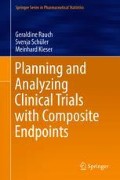Abstract
The resulting treatment effect of a composite endpoint alone is often difficult to interpret as the individual components do not necessarily contribute the same amounts to this net effect. As discussed before, current guidelines therefore recommend to always analyze the components of composite endpoints separately. The current well-established practice is to provide descriptive analyses of the components and the composite in addition to the confirmatory analysis of the composite. However, there exist a number of different methods to evaluate the single components in a descriptive manner. In this chapter, the most common approaches for a descriptive analysis of the individual components will be presented and discussed. Moreover, we will deduce recommendations for a meaningful presentation and interpretation of the component-specific results.
Access this chapter
Tax calculation will be finalised at checkout
Purchases are for personal use only
References
Allignol, A., Schumacher, M., & Beyersmann, J. (2011). Empirical transition matrix of multi-state models: The etm package. Journal of Statistical Software, 38, 1–15.
Beyersmann, J., Allignol, A., & Schumacher, M. (2012). Competing risks and multistate models with R. New York: Springer.
Cheung, Y. B., Xu, Y., Tan, S. H., Cutts, F., & Milligan, P. (2010). Estimation of intervention effects using first or multiple episodes in clinical trials: The Andersen-Gill model re-examined. Statistics in Medicine, 29, 328–336.
Cox, D. (1972). Regression models and life tables. Journal of the Royal Statistical Society B, 34, 187–220.
ICH. (1998). Statistical principles for clinical trials - E9. ICH. http://www.ich.org/fileadmin/Public_Web_Site/ICH_Products/Guidelines/Efficacy/E9/Step4/E9_Guideline.pdf. Accessed February 6, 2018.
Kalbfleisch, J. D., & Prentice, R. L. (1981). Estimation of the average hazard ratio. Biometrika, 68, 105–112.
Kaplan, E. L., & Meier, P. (1958). Nonparametric estimation from incomplete observations. Journal of the American Statistical Association, 53, 457–481.
Machin, D., Cheung, Y. B., & Parmer, M. K. B. (2006). Survival analysis: A practical approach (2nd ed.). New York: Wiley.
Pintilie, M. (2006). Competing risks: A practical perspective. Chichester: John Wiley & Sons.
Rauch, G., Kieser, M., Binder, H., Bayes-Genis, A., & Jahn, A. (2016). Time-to-first-event versus recurrent-event analysis - Points to consider for selecting a meaningful analysis strategy in clinical trials with composite endpoints. DOI: 10.1007/s00392-018-1205-7.
Rauch, G., Kieser, M., Ulrich, S., Doherty, P., Rauch, B., Schneider, S., et al. (2014). Competing time-to-event endpoints in cardiology trials: A simulation study to illustrate the importance of an adequate statistical analysis. European Journal of Preventive Cardiology, 21, 74–80.
Author information
Authors and Affiliations
Rights and permissions
Copyright information
© 2017 Springer International Publishing AG, part of Springer Nature
About this chapter
Cite this chapter
Rauch, G., Schüler, S., Kieser, M. (2017). Descriptive Analysis of the Components. In: Planning and Analyzing Clinical Trials with Composite Endpoints. Springer Series in Pharmaceutical Statistics. Springer, Cham. https://doi.org/10.1007/978-3-319-73770-6_16
Download citation
DOI: https://doi.org/10.1007/978-3-319-73770-6_16
Published:
Publisher Name: Springer, Cham
Print ISBN: 978-3-319-73769-0
Online ISBN: 978-3-319-73770-6
eBook Packages: Mathematics and StatisticsMathematics and Statistics (R0)

